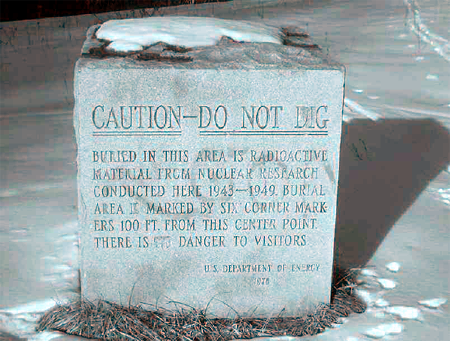
Litteratur |
Breccia-pipe uranium mining in the Grand Canyon region and
implications for uranium levels in Colorado River water. / :
Jon E. Spencer ; Karen Wenrich. Arizona Geological Survey,
2011.
-
http://azmemory.azlibrary.gov/cdm/ref/collection/statepubs/id/29325
CRS: Civilian Nuclear Waste Disposal. / : Mark Holt.
2015.
'Spent Nuclear Fuel Program
The Nuclear Waste Policy Act (P.L. 97-425), as amended in 1987,
required DOE to focus on Yucca Mountain, Nevada, as the site of a
deep underground repository for spent nuclear fuel and other highly
radioactive waste. The state of Nevada has strongly opposed
DOE’s efforts on the grounds that the site is unsafe,
pointing to potential volcanic activity, earthquakes, water
infiltration, underground flooding, nuclear chain reactions, and
fossil fuel and mineral deposits that might encourage future human
intrusion.'
CRS: U.S. Spent Nuclear Fuel Storage. / James D. Werner.
2012. - 56 s. - http://www.fas.org/sgp/crs/misc/R42513.pdf
GAO: Testimony Before the Committee on Energy and Natural
Resources, U.S. Senate Saturday, December 6, 2003 Nuclear Waste
Cleanup : Preliminary Observations on DOE’s Cleanup of
the Paducah Uranium Enrichment Plant Statement of Robin M. Nazzaro,
Director Natural Resources and Environment.
- http://www.gao.gov/new.items/d04278t.pdf
House Committee on Interior and Insular Affairs (now House
Committee on Natural Resources). Subcommittee on Energy and the
Environment: Disposal of Low Level Radioactive Waste (July
26, 1990). 1-DVD - 'The subcommittee heard testimony on a new
policy by the Nuclear Regulatory Commission which deregulates
low-level atomic waste from hospitals, labs and nuclear plants. The
subcommittee also released documentation of Environmental
Protection Agency and some National Regulatory Commission staff
advisers opposition to the new regulations developed by the
National Regulatory Commission. Some lawmakers' also expressed
concern that certain states would become dumping grounds for the
atomic waste'.
- http://www.archive.org/details/org.c-span.13300-1
Hvad indlandsisen gemmer. / : Owen Wilkes. Forsvar, 1980:1
s. 18-20.
Nuclear waste: A hot business? / : Thomas Gaulkin. the
Bulletin of the Atomic Scientists, May 24, 2019. It usually takes
decades for defunct nuclear plants in the United States to be taken
apart and cleaned up so the land can be developed for other
purposes. Long after the main facilities are dismantled and their
sites remediated, spent fuel remains radioactive and takes years to
cool off in pools before it can be safely placed in concrete
cylinders—dry casks, in industry lingo—for interim
storage that could last years or even decades. Utility companies
stuck with these useless sites often delay the costly cleanups as
long as they possibly can.
Nuclear Wastelands : A global guide to nuclear
weapons production and its health and environmental effects / by a
special commission of International
Psysicians for the Prevention of Nuclear War and the Institute
for Energy and Environmental Research ; edited by Arjun Makhijiani,
Howars Hu and Katherine Yih. - Cambridge ; London : The MIT Press,
1995.
Nuclear Wastes in the Arctic: An Analysis of Arctic and
Other Regional Impacts from Soviet Nuclear Contamination,
OTA-ENV-623
- Washington, DC: U.S. Government Printing Office, September 1995.
- 244 s.
- http://www.fas.org/ota/reports/9504.pdf
Spent Nuclear Fuel Pools in the U.S.: Reducing the Deadly
Risks of Storage.
/ : Robert Alvarez. Institute for Policy Studies, 2011.
Uddannelses- og Forskningsministeriet, 14. marts 2018:
Regeringen og Folketingets partier er enige om, at det radioaktive
affald fortsat oplagres på Risø indtil senest 2073,
hvor et dybtliggende slutdepot skal kunne tages i brug.
Faciliteterne på Risø skal opgraderes, og mulighederne
for at eksportere det mest radioaktive affald vil fortsat blive
afsøgt.
Regeringen (Venstre, Liberal Alliance og Det Konservative
Folkeparti), Socialdemokratiet, Dansk Folkeparti, Radikale Venstre,
Socialistisk Folkeparti, Alternativet og Enhedslisten er enige om
en langsigtet løsning for Danmarks radioaktive affald.
Regeringen har i dag fremsat et forslag til folketingsbeslutning,
der indebærer en opgradering af Dansk Dekommissionerings
lagerfaciliteter på Risø. Opgraderingen vil
sørge for, at oplagringen af det radioaktive affald
også i fremtiden sker under betryggende forhold og tager
hensyn til højvandesikring, klimastyring og øget
affaldsvolumen i takt med, at anlæggene på Risø
afvikles.
A Visual Description of the Concrete Exterior of the Cactus
Crater Containment Structure. / : Terry Hamilton.Center for
Accelerator Mass Spectrometry, Lawrence Livermore National
Laboratory, 2013.
During the Radiological Cleanup of Enewetak Atoll (1972-1980),
radioactively contaminated soil was removed by excision and buried
inside the Cactus nuclear test crater on Runit Island.
Wallace, Helen Rock Solid? A scientific review of geological
disposal of high-level radioactive waste.
GeneWatch UK, 2010. - 67 s.